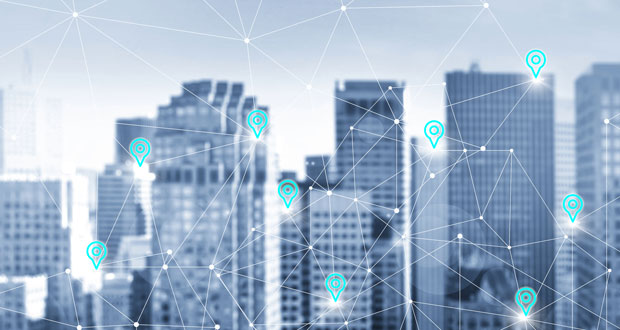 We must take action to drastically increase efficiency if the UK is to remain competitive in the face of surging energy costs. Connected buildings can help us meet these objectives, argues Jamie Cameron, Director of Digital Solutions UK&I & EMEALA, Johnson Controls
We must take action to drastically increase efficiency if the UK is to remain competitive in the face of surging energy costs. Connected buildings can help us meet these objectives, argues Jamie Cameron, Director of Digital Solutions UK&I & EMEALA, Johnson Controls
A report from the Institute for Government warned that the UK’s buildings are among the least efficient in Europe. Businesses and Smart Buildings play a core role in the efficiency imperative. Using connected, data-driven strategies with building management solutions, they have the opportunity to create environments that are sustainable, efficient, healthy and cost-effective.
Luckily, there are five key strategies businesses can apply.
UTILISE OPEN PROTOCOLS
When building systems speak to each other, delivering collective data insights, building managers can help create better business outcomes. This includes reduced energy spend and IT security risk, increased operational efficiencies, and safe, comfortable and productive environments. To achieve this, when selecting Operation Technology in the building it is crucial that technology with open protocols is selected. Using standardisation of data formats and communications protocols makes it easier to ensure compatibility across different systems and networks, maintain systems efficiently, and expand capabilities as technologies advance.
When choosing a provider to improve your building, open protocol technology means there is a common language between systems and data. It, therefore, makes it easier and more cost-effective to integrate and expand based on developing needs and technologies. It also enables simpler integrations between different systems, bringing together a cohesive approach under one common language.
USE THE CLOUD TO BRIDGE THE GAP BETWEEN SILOED SOLUTIONS
The focus on open systems throws up another important consideration for connected buildings. Often the data that exists across solutions are siloed and disconnected, obscuring the bigger picture and limiting building managers to small, incremental changes that prevent them from maximising smart building investments.
To reach this potential, it’s important to get below the surface level of intelligent technologies to unlock the deeper insights they can generate. This happens when we connect smart technology systems together to create an ecosystem or platform for smart solutions. The data and insights this creates can then be analysed to make vast improvements across a building and even the whole enterprise. To make this a reality, the data needs to be connected and easily accessible in the cloud.
From here, it is then possible to move up the data value ladder, unlocking the true benefits of ‘smart’. On the surface level, data can be descriptive, telling us what is happening now. It is then possible to move up the levels; diagnostic, predictive, prescriptive and finally, the zenith of cognitive data where AI and automation come into their own.
EXPLORE NEXT-GEN SUSTAINABILITY WITH AI AND DIGITAL TWINS
With access to more data through these connected cloud systems, AI and machine learning can be harnessed to optimise building performance across myriad targets.
AI-driven analytics collects building data and applies machine learning to give granular insight into building performance in real-time. This leads to opportunities to save energy and operating expenses while enhancing building environments.
Such systems can also be harnessed in the creation of digital twins. These digital replicas of buildings enable the safe exploration of alternative sustainability strategies – modelling maintenance, upgrades, and sustainability decisions. For example, about 40 per cent of carbon dioxide (CO2) emissions worldwide are generated by the building sector. Research from Accenture found that digital twins and related technologies can be used to cut energy use and carbon emissions in half.
TAKE A HUMAN-CENTRED APPROACH
Talking about building tech alongside humans may sound like an oxymoron, but the two go together. Building engineers and facilities managers need to be innovative and turn to full system design while also understanding what each component in their building does. We need people in our buildings that understand the whole journey, so they can get the best out of it and make buildings truly smart.
It’s important to remember that smart technologies are not just about efficiency and sustainability. They must also work for building occupants and create environments where people can flourish. One immediately noticeable benefit to employees of smart buildings is the increased comfort, convenience and safety of data-driven buildings, from air quality to temperature and lighting.
Let’s not forget, however, that today’s workforce holds green credentials in high esteem, especially emerging talent in younger generations. If a business can demonstrate its commitment to sustainability, it can hope to become a more desirable employer while also achieving higher productivity levels.
MAKE CONNECTIONS FOR A FUTURE PURPOSE
Innumerable technological solutions promise to deliver discrete gains, but we need to move away from thinking about single solutions. If we get the technology right in our buildings now, we can transform how we use them in the future. The needs and expectations of users, alongside the global imperative to reach net zero now define the future of our buildings.
To deliver this future, we must start with connections; connecting every system in a building, including fire safety, HVAC, lighting and security, and concentrating on fully formed objectives that make the most of powerful data tools, rich analytics and human oversight. This is not only to ensure we have a great today, but so we work towards a better future.





